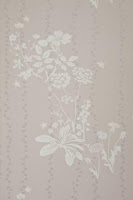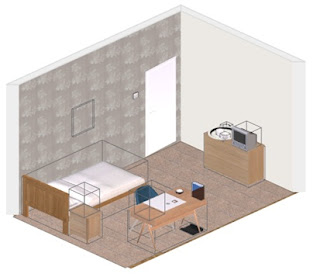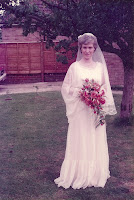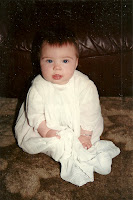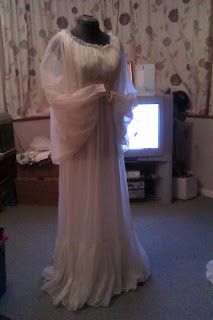During Steffi’s tutorial she drew my attention to the
photographer, Trish Morrissey, particularly her series ‘Seven Years’ consisting
of large-scale colour photographs. She deconstructs family photography by
mimicking it, Morrissey becomes director, author and actor staging herself and
her sister in fictional scenarios based on conventional family snapshots.
 |
| April 16, 1967 |
Period
clothing, props & the setting of her own, others and family house in Dublin
are combined to construct realistic looking family portraits set in the 1970s
& 80s looking particularly back at her own childhood in these years. She
and her sister become different characters in each image such as their parents,
aunts & various friends, employing body language to reveal the
psychological tensions present in all family relations.
No names appear beneath the photographs of these mundane scenes
just dates which allow the viewer to gather the decade & time of year. By
not titling the images, the event becomes generalisable and the people become
anonymous allowing the audience to relate to the events. Morrissey looks at the
‘family album as fiction’ with a feel of innocence existing in the scenes which
could suggest something deeper & darker under the façade.
 |
| August 8th, 1982 |
Trish Morrissey is allowing the viewer to witness her photographic
practise- imagining, remembering, planning, staging, acting & looking. She
is exploring issues such as family experiences, pastimes, fashions, feminine
& masculine roles and relationships between the figures and their
surroundings. She uses this medium not to define the subject but probe their
boundaries seen in everyday life.
She is capturing moments that we all expect to experience in our
lives, these events are very mundane however I still want to look at the bigger
events in our lives that we aspire to experience that are accompanied by these ordinary
occasions important in their own rights. The images are dated in the 70s &
80s which makes the audience believe that the images were taken in these decades;
where are they & who are they, I then begin to wonder what has happened to
the people and clothes. This leads to the idea of waste, that even though they
were obviously of some importance at this point in time to capture the whole
experience everything in the photograph could now be wasted, destroyed over
time.
 |
| September 20th, 1985 |
Through researching her work I have begun to consider further the
way I will present my clothes & possibly only presenting clothes that I am
personally aspiring to fill in my future & that most other people also seek
to achieve. All of the clothes I found in my attic, the ball dress, the wedding
dress, the prom dress, all belonged to important people in my life who I look
up to; this has made me begin to rethink my shoot possibly making the subject
much more personal to me thinking about the way that my dreams of these events
stay fresh while the years pass and the clothes still lie wasted waiting to be
filled.
 |
| 'Betty' 1988 |
My attention was also brought to a photorealistic painting by
Gerhard Richter titled ‘Betty, 1988’, Richter’s daughter is posed facing away
from the audience naturally lit in a bright outfit which stands out boldly
against the dark backdrop. This high contrast brings clarity to the image, this
is enhanced by the distinction created by the mixture of sharp and soft,
blurred aspects in the image. This unusual practise makes the audience focus
mainly on the shoulder leading the viewer to follow the model’s line of site
into the image. It arouses the curiosity of the audience as to what the subject
is looking at, what she is responding to; it then leads us to consider her
appearance, the model becomes anonymous, faceless and she could be anyone to
anyone.
There is a dynamic feel to this portrait but also a sense of
frozen, captured time; despite this you are waiting for her to turn around. Because
you are left waiting and wondering for eternity I feel the audience is led to
believe that she will have the most beautiful face in the world and it can be
whoever you want it to be.
Richter seemed to mistrust what his own eyes witnessed so by
basing his paintings on scenes captured by a camera he found that this was
reality and true; he ‘always loathed subjectivity’ yet the camera captures
reality with a sense of objectivity that he could not personally grasp with his
own eyes.
His daughter, the subject is on the edge of adulthood, turning
away from the viewer to contemplate the darkness behind her; this could
metaphorically represent the expectations she has put on herself to achieve in
the future. A darker feel appears which seems out of place with the peaceful
appearance of the work; he is lowering is critical view in portraits of his
family members making touching portraits of his growing daughters. Through this
Richter emits a distinct feeling of loss in this painting of his daughter as
she rises into adulthood. Facing away she is disconnecting herself from the
bonds to her father setting out on her journey leaving only memories of her
presence.
She sits leaning away from the black void as if fearing the future and what it may bring as people do as the transcend from childhood to adulthood; there is no perception of depth which draws the audience even further into the image intrigued again as to what she is looking at. Not so much in this painting by in many of richter's portraits the figures seem to jitter in time never quite still as if they could be anywhere & anyone.
She is thought to be looking at her father’s grey monochrome
paintings in the background which could be highlighting her future ambitions
and aspirations. The precise way he paints these portraits allows the viewer to
analyse every minute detail of the model and clothing; I imagine in my
photographs I could use this to highlight their wear and tear through use &
waste by using a large format camera. A painting can convey a sense of
caring that a photograph does not and despite being taken from a photograph
this painting has a personal touch to it. This has made me begin to consider
whether my clothes need to be figureless at all and whether I could wear them
to highlight this idea of the need to ‘fill their shoes’. Also by doing this I
am showing my need and want to care for these discarded items of clothing
bringing them out of the darkness represented by a dark background into the
focus.
After doing this research I feel that I still want to experiment with my previous, initial idea of shooting the clothes bodyless as if they have been discarded and therefore have lost the memory of their previous owner; however I also want to develop this new idea and represent these ideas of waste in a new way.
I will also start looking more into these new ideas that have come out of the tutorial:
- Aspirational expectations- live up to future expectations- 'fill their shoes' filling previosu generations dresses- my nan, mum and older sister.
- I want to hone in on my theme more precisely- what am I exactly focussing on? What do I want from the viewer?
- Clothes are a representation of you, your personality, your past/family etc.
- Rethink- is it important that they are figureless/bodyless like Yuki Onodera or Danny Treacy's work? Why does it need to be hollow?
- Is there something to show that the items of clothing have been worn or mistreated? eg. rips, stains
- The use of large format photography to enhance the detail of the dresses & exaggerate the feeling of waste in a very personal way.
- By having a dark background which I stand in front of will this draw my audience into the image, fear of what's beyond the figure, the blackness where the clothes came from and will be returned to.







